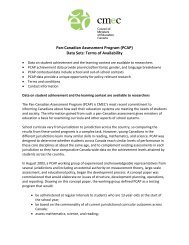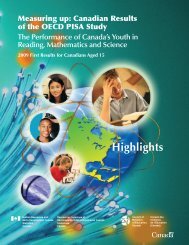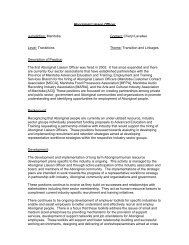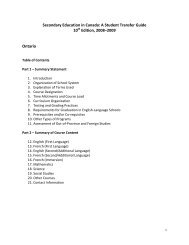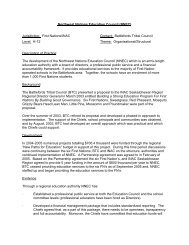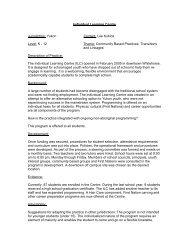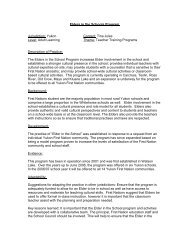highlights - Conseil des ministres de l'Ãducation du Canada (CMEC)
highlights - Conseil des ministres de l'Ãducation du Canada (CMEC)
highlights - Conseil des ministres de l'Ãducation du Canada (CMEC)
Create successful ePaper yourself
Turn your PDF publications into a flip-book with our unique Google optimized e-Paper software.
Pan-Canadian RePoRt onoffiCial languages in e<strong>du</strong>Cation2005–06 to 2008–09HIGHLIGHTS
The Council of Ministers of E<strong>du</strong>cation, <strong>Canada</strong> (<strong>CMEC</strong>), was formedin 1967 by the provincial and territorial ministers responsible fore<strong>du</strong>cation to provi<strong>de</strong> a forum in which they could discuss matters ofmutual interest, un<strong>de</strong>rtake e<strong>du</strong>cational initiatives cooperatively,and represent the interests of the provinces and territories withnational e<strong>du</strong>cation organizations, the fe<strong>de</strong>ral government, foreigngovernments, and international organizations. <strong>CMEC</strong> is the nationalvoice for e<strong>du</strong>cation in <strong>Canada</strong> and, through <strong>CMEC</strong>, the provinces andterritories work collectively on common objectives in a broad rangeof activities at the elementary, secondary, and postsecondary levels.Council of Ministers of E<strong>du</strong>cation, <strong>Canada</strong>95 St. Clair Avenue West, Suite 1106Toronto, Ontario M4V 1N6Telephone: 416-962-8100Fax: 416-962-2800E-mail: cmec@cmec.caNote of AppreciationThe Council of Ministers of E<strong>du</strong>cation, <strong>Canada</strong>, would like to thankthe provincial and territorial officials responsible for official languagesin e<strong>du</strong>cation for their participation in writing this report.We acknowledge the financial support of the Government of <strong>Canada</strong>through the Department of Canadian Heritage.
Pan-Canadian RePoRt onoffiCial languages in e<strong>du</strong>Cation2005–06 to 2008–09HIGHLIGHTS
Table of ContentsIntro<strong>du</strong>ction . . . . . . . . . . . . . . . . . . . . . . . . . . . . . . . . . . . . . . . . . . . . . . 6Alberta ................................................... 8Highlights of Achievements in Minority-Language E<strong>du</strong>cation ..... 9Highlights of Achievements in Second-Language Instruction.....10British Columbia ......................................... 12Highlights of Achievements in Minority-Language E<strong>du</strong>cation ....13Highlights of Achievements in Second-Language Instruction.....14Manitoba ................................................ 16Highlights of Achievements in Minority-Language E<strong>du</strong>cation ....17Highlights of Achievements in Second-Language Instruction.....18New Brunswick .......................................... 20Highlights of Achievements in Minority-Language E<strong>du</strong>cation ....21Highlights of Achievements in Second-Language Instruction.....22Newfoundland and Labrador ............................. 24Highlights of Achievements in Minority-Language E<strong>du</strong>cation ....25Highlights of Achievements in Second-Language Instruction.....26Northwest Territories .................................... 28Highlights of Achievements in Minority-Language E<strong>du</strong>cation ....29Highlights of Achievements in Second-Language Instruction.....30Nova Scotia ............................................. 32Highlights of Achievements in Minority-Language E<strong>du</strong>cation ....33Highlights of Achievements in Second-Language Instruction.....34
AlbertaHIGHLIGHTS OF ACHIEVEMENTS INMINORITY-LANGUAGE EDUCATIONAlberta’s achievements in minority-language e<strong>du</strong>cation, between2005–06 and 2008–09, inclu<strong>de</strong>d the following outcomes supportedby fe<strong>de</strong>ral–provincial funding arrangements:• Francophone teachers received bursaries that enabled them toparticipate in professional <strong>de</strong>velopment workshops and to perfecttheir pedagogical and linguistic knowledge. Their professional<strong>de</strong>velopment covered, in particular, the teaching of specializedsubject matter, the integration of stu<strong>de</strong>nts at risk, interculturaldialogue, and building i<strong>de</strong>ntity.• A full-time kin<strong>de</strong>rgarten program was implemented in allfrancophone elementary schools. This gives young children theopportunity to attain language proficiency in French, and thus beready to enter the French-language school system in Gra<strong>de</strong> 1. From2005–06 to 2008–09, 2,453 stu<strong>de</strong>nts in French-language schoolsbenefitted from this improvement.• Digital resources in mathematics, chemistry, biology, physics,social studies, and science, and the courses in the series“Connaissances et employabilité” [knowledge and employability]were <strong>de</strong>veloped. This ma<strong>de</strong> it possible to broa<strong>de</strong>n the range offrancophone distance e<strong>du</strong>cation courses available to stu<strong>de</strong>nts insmall schools or schools located in remote areas.Pan-Canadian Report on Official Languages in E<strong>du</strong>cation 2005–06 to 2008–09 HIGHLIGHTS 9
alberta• Campus Saint-Jean (CSJ) of the University of Alberta continuedto provi<strong>de</strong>, through innovative teaching and research, a qualityuniversity e<strong>du</strong>cation in the French language. The number ofun<strong>de</strong>rgra<strong>du</strong>ate <strong>de</strong>gree program options increased from 7 to 12. Thenumber of majors, minors, and honours programs also increasedsubstantially; currently, Campus Saint-Jean offers 22 majors and29 minors within its un<strong>de</strong>rgra<strong>du</strong>ate and gra<strong>du</strong>ate programofferings. Gra<strong>du</strong>ate enrolment in the master of e<strong>du</strong>cation programwas increased by a Calgary cohort of 20 stu<strong>de</strong>nts. Overall enrolmentat Campus Saint-Jean increased by 32 per cent — from 582 to 770stu<strong>de</strong>nts. The percentage of new admissions whose mother tongueis French increased from 23.4 per cent in 2005–06 to 30.4 per centin 2008–09.• An ambitious new plan to launch college-level programming atCampus Saint-Jean was <strong>de</strong>veloped. Staff were hired and facilityrenovations begun. Program implementation will begin in 2010–11with a diploma offered in business administration.HIGHLIGHTS OF ACHIEVEMENTS INSECOND-LANGUAGE INSTRUCTIONAlberta’s achievements in second-language instruction, between2005–06 and 2008–09, inclu<strong>de</strong>d the following outcomes supported byfe<strong>de</strong>ral–provincial funding arrangements:• The province un<strong>de</strong>rtook to re<strong>du</strong>ce the dropout rate from coursesin French as a second language, particularly at the secondary level,and to increase the percentage of stu<strong>de</strong>nts from the linguisticmajority who are able to express themselves in French. In 2004–05,147,111 stu<strong>de</strong>nts were enrolled in French immersion and French-asa-second-languageprograms. This number increased to 155,191 in2005–06, then to 169,706 in 2006–07, to 176,919 in 2007–08, and to180,564 in 2008–09.• The province also helped to protect against the risk of a shortageof competent teachers of French as a second language, by helpingschool authorities and other organizations to adopt strategies forretaining existing teaching staff and for recruiting new teachers.During the agreement, some 300 teachers participated in languagetraining and workshops <strong><strong>de</strong>s</strong>igned to increase the number ofqualified teachers.10Pan-Canadian Report on Official Languages in E<strong>du</strong>cation 2005–06 to 2008–09 HIGHLIGHTS
• Stu<strong>de</strong>nt financial support for French as a second language consistsof fellowships for anglophone stu<strong>de</strong>nts pursuing full-time studiesin French at Alberta postsecondary institutions (primarily atCampus Saint-Jean) and out of province. From 2005–06 to 2008–09,this funding supported 956 stu<strong>de</strong>nts attending Alberta-basedinstitutions and 117 stu<strong>de</strong>nts in out-of-province programs.• Exchange and travel opportunities — involving experiential learningactivities in Québec and France — were provi<strong>de</strong>d to more than200 postsecondary stu<strong>de</strong>nts <strong>du</strong>ring the 2005–06 to 2008–09 period.alberta• The University of Calgary was able to increase its capacityto offer French-language programming. Between 2005–06 and2008–09, the French Centre at the University of Calgary offereda total of 57 <strong>de</strong>gree courses in French to 1,079 stu<strong>de</strong>nts. Over thesame period, 201 stu<strong>de</strong>nts participated in five immersion weekendsoffered by the French Centre.To learn more about Alberta’s achievements inofficial languages in e<strong>du</strong>cation, please consultthe Pan-Canadian Report on Official Languages in E<strong>du</strong>cation2005–06 to 2008–09 on-line at www.cmec.ca.Pan-Canadian Report on Official Languages in E<strong>du</strong>cation 2005–06 to 2008–09 HIGHLIGHTS 11
A total of 11 universities and colleges in British Columbiareceived funds over the course of the agreementto offerpre-service and in-service courses in French.Stu<strong>de</strong>nts had the opportunityto pursuepostsecondary studies that would enablethem to become e<strong>du</strong>cators in core French andFrench immersion.12Pan-Canadian Report on Official Languages in E<strong>du</strong>cation 2005–06 to 2008–09 HIGHLIGHTS
British ColumbiaHIGHLIGHTS OF ACHIEVEMENTS INMINORITY-LANGUAGE EDUCATIONBritish Columbia’s achievements in minority-language e<strong>du</strong>cation,between 2005–06 and 2008–09, inclu<strong>de</strong>d the following outcomessupported by fe<strong>de</strong>ral–provincial funding arrangements:• As of September 30, 2008, there were 4,222 stu<strong>de</strong>nts enrolled in the<strong>Conseil</strong> scolaire francophone <strong>de</strong> la Colombie-Britannique [francophoneschool board of British Columbia] (CSF), an increase of 16 per centsince the 2005–06 school year. The CSF was able to hire 157 newteachers. New teachers participated in a five-day orientationprogram, training sessions, and a mentoring program.• The preschool and kin<strong>de</strong>rgarten levels witnessed growth. Allkin<strong>de</strong>rgarten stu<strong>de</strong>nts within the minority-language school systemhad access to a full-day francophone program, and kin<strong>de</strong>rgartenenrolment increased by 20 per cent. During the same time period,the CSF opened four new preschools, bringing the total of CSFpreschools to 15.• The province <strong>de</strong>veloped, in collaboration with the CSF, a newFrançais langue première, M à 12 e année [French first language, K to 12]draft curriculum.Pan-Canadian Report on Official Languages in E<strong>du</strong>cation 2005–06 to 2008–09 HIGHLIGHTS 13
itish columbia• To enhance stu<strong>de</strong>nts’ learning experience and thus stu<strong>de</strong>ntretention, iBook computers were distributed to 60 stu<strong>de</strong>nts and300 staff members in 2005–06 and to more than 2,000 stu<strong>de</strong>ntsand 300 staff members in 2008–09. During the same time period,90 per cent of all CSF teachers used computers in their classroom.A cyber pédagogue [computer specialist] team was created andtrained; it i<strong>de</strong>ntified teaching strategies that would better supportstu<strong>de</strong>nt achievement, foster stu<strong>de</strong>nts’ <strong>de</strong>velopment of culturali<strong>de</strong>ntity and a sense of belonging to their francophone community,and facilitate the implementation of new learning technologies tobetter respond to stu<strong>de</strong>nts’ needs.• Simon Fraser University <strong>de</strong>veloped and <strong>de</strong>livered French-languagee<strong>du</strong>cation courses for a new minor-in-French program; offeredthe gra<strong>du</strong>ate diploma program in French e<strong>du</strong>cation; and <strong>de</strong>liveredthe gra<strong>du</strong>ate master’s program and the French-language doctoralprogram in e<strong>du</strong>cational lea<strong>de</strong>rship.HIGHLIGHTS OF ACHIEVEMENTS INSECOND-LANGUAGE INSTRUCTIONBritish Columbia’s achievements in second-language instruction,between 2005–06 and 2008–09, inclu<strong>de</strong>d the following outcomessupported by fe<strong>de</strong>ral–provincial funding arrangements:• Fifty-seven school districts were able to enhance and expan<strong>de</strong>xisting core French programs.• School districts offered their stu<strong>de</strong>nts access to quality Frenchimmersion programs: 254 public schools offered French immersionprograms to 42,474 stu<strong>de</strong>nts; four in<strong>de</strong>pen<strong>de</strong>nt schools offeredFrench immersion programs to 513 stu<strong>de</strong>nts. In 2008–09,42,474 stu<strong>de</strong>nts were enrolled in French immersion programsin the public schools, representing an unprece<strong>de</strong>nted highof 6.5 per cent of the province’s total stu<strong>de</strong>nt population.• Core French and French immersion teachers had the opportunityto upgra<strong>de</strong> their teaching and linguistic skills: 130 teachersrequested bursaries in 2005–06; 147 requested them in 2006–07;154 in 2007–08; and 159 in 2008–09. Some teachers took a varietyof courses including intensive French immersion programs whileothers pursued master’s <strong>de</strong>grees. Collège É<strong>du</strong>cacentre <strong>de</strong>veloped andoffered French-for-teachers workshops to 125 core French teachersfrom four districts.14Pan-Canadian Report on Official Languages in E<strong>du</strong>cation 2005–06 to 2008–09 HIGHLIGHTS
• Francophone organizations offered a variety of cultural activitiesand events, enriching thousands of BC French immersion stu<strong>de</strong>nts’language skills and un<strong>de</strong>rstanding of French culture: theatricalplays “Des flacons pour Alicia,” “Regar<strong>de</strong>-moi,” “Le Nez,” and “Écran <strong>de</strong>fumée”; and e<strong>du</strong>cational programs “Le capteur <strong>de</strong> rêve et le loup : unvoyage dans l’imaginaire autochtone” and “La Francophonie autour <strong>du</strong>Globe.” As well, sixteen author/illustrators visited 154 BC schoolsto offer 240 workshops.• The University of Victoria was able to offer, after years of preparatorygroundwork, the Professional Specialization Certificate in TeachingFrench Immersion and the Cre<strong>de</strong>ntial in Teaching French as a SecondLanguage in Middle School, two in-service programs <strong><strong>de</strong>s</strong>igned torespond to the need for qualified teachers in French second-languageprograms in the Greater Victoria area. Over 100 teachers registeredfor these programs.british columbiaTo learn more about British Columbia’s achievementsin official languages in e<strong>du</strong>cation, please consult thePan-Canadian Report on Official Languages in E<strong>du</strong>cation2005–06 to 2008–09 on-line at www.cmec.ca.Pan-Canadian Report on Official Languages in E<strong>du</strong>cation 2005–06 to 2008–09 HIGHLIGHTS 15
Fe<strong>de</strong>ral financial assistance has greatly contributed tothe organization of annual provincial conferences forschool principals, division managerial staff,e<strong>du</strong>cation partners, and parents.Fe<strong>de</strong>ral funds make it possibleto offer support to immersion stu<strong>de</strong>ntswho want to continuetheir studiesin French.16Pan-Canadian Report on Official Languages in E<strong>du</strong>cation 2005–06 to 2008–09 HIGHLIGHTS
ManitobaHIGHLIGHTS OF ACHIEVEMENTS INMINORITY-LANGUAGE EDUCATIONManitoba’s achievements in minority-language e<strong>du</strong>cation, between2005–06 and 2008–09, inclu<strong>de</strong>d the following outcomes supported byfe<strong>de</strong>ral–provincial funding arrangements:• The Division scolaire franco-manitobaine [franco-Manitoban schooldivision] (DSFM) ma<strong>de</strong> kin<strong>de</strong>rgarten the focus of its recruitmentefforts and, from 2005–06 to 2008–09, enrolment increasedfrom 4,569 stu<strong>de</strong>nts to 4,804. This was a gain of 235 stu<strong>de</strong>nts,representing an increase of 5.1 per cent.• In April 2007, a new French-language school opened in a thrivingcommunity in the southeastern part of Winnipeg — the Centrecommunautaire Léo-Rémilliard, which accepts stu<strong>de</strong>nts from Gra<strong>de</strong> 8to Gra<strong>de</strong> 12. This addition does much to help maintain the DSFM’senrolment and also provi<strong><strong>de</strong>s</strong> another environment for welcomingfrancophone stu<strong>de</strong>nts in the community.Pan-Canadian Report on Official Languages in E<strong>du</strong>cation 2005–06 to 2008–09 HIGHLIGHTS 17
manitoba• The Direction <strong><strong>de</strong>s</strong> ressources é<strong>du</strong>catives françaises [French-languagee<strong>du</strong>cation resources branch] (DREF) of the Bureau <strong>de</strong> l’é<strong>du</strong>cationfrançaise [French-language e<strong>du</strong>cation bureau] (BEF) acquire<strong>de</strong><strong>du</strong>cational and instructional materials for e<strong>du</strong>cation staff workingwith stu<strong>de</strong>nts from kin<strong>de</strong>rgarten to Gra<strong>de</strong> 12, and provi<strong>de</strong>d themwith the services of its library. This ma<strong>de</strong> over 63,000 Frenchlanguageresources available to the schools and to provincialresi<strong>de</strong>nts who were interested in them. In 2008–09, the BEF librarylent over 31,000 resources to teaching staff in the French schools.• The DSFM partnered with the Collège universitaire <strong>de</strong> Saint-Boniface(CUSB), Saint Boniface’s French-language university college, andwith the BEF Division of the Department of E<strong>du</strong>cation to supportthe <strong>de</strong>livery of Petites écoles en réseau [small networked schools](PEER), a course in sciences, to 24 Gra<strong>de</strong> 9 stu<strong>de</strong>nts in four smallrural schools. The stu<strong>de</strong>nts in these schools were brought togetherthrough virtual collaboration.• Francophone stu<strong>de</strong>nts wishing to pursue their studies in Frenchat the postsecondary level received financial support. In 2008–09,some 60 gra<strong>du</strong>ating stu<strong>de</strong>nts whose first language was Frenchreceived a bursary for this purpose. This was also the case for49 postsecondary stu<strong>de</strong>nts who wanted to take a program ofstudy in French that was not offered in Manitoba.HIGHLIGHTS OF ACHIEVEMENTS INSECOND-LANGUAGE INSTRUCTIONManitoba’s achievements in second-language instruction, between2005–06 and 2008–09, inclu<strong>de</strong>d the following outcomes supportedby fe<strong>de</strong>ral–provincial funding arrangements:• Enrolment in the French immersion program increased from17,604 stu<strong>de</strong>nts in 2005–06 to 18,563 in 2008–09, a gain of959 stu<strong>de</strong>nts or 5.4 per cent. The number of French immersionstu<strong>de</strong>nts who obtained their secondary school diploma increasedfrom 759 stu<strong>de</strong>nts in 2006 to 787 in 2009.• The Web sites of French for Life and French for Career Options,two projects <strong>de</strong>veloped by Canadian Parents for French – Manitoba,the Association manitobaine <strong><strong>de</strong>s</strong> directeurs d’immersion [Manitobaassociation of immersion directors], and the Manitoba Associationof Teachers of French, continue to enjoy enormous success inpromoting the learning of French.18Pan-Canadian Report on Official Languages in E<strong>du</strong>cation 2005–06 to 2008–09 HIGHLIGHTS
• The BEF carried out an oral and written evaluation of the stu<strong>de</strong>ntsenrolled in intensive French (IF) and enhanced French (EF) courses,in support of school divisions that had implemented pilot projectsin these subject areas, and was able to provi<strong>de</strong> school divisionswith a division report and a <strong><strong>de</strong>s</strong>criptive profile for each stu<strong>de</strong>ntenrolled in the IF or EF course, enabling school principals to informparents of their children’s progress.• Immersion stu<strong>de</strong>nts wishing to continue their studies in Frenchat the postsecondary level received financial support. In 2008–09,some 60 bursaries were awar<strong>de</strong>d to stu<strong>de</strong>nts who were gra<strong>du</strong>atingfrom immersion schools, and 12 bursaries were granted topostsecondary stu<strong>de</strong>nts who wanted to take a program of studiesin French that was not offered in Manitoba.manitoba• The capacity of the Service <strong>de</strong> perfectionnement linguistique [linguisticproficiency upgrading service] (SPL) of the CUSB was maintainedand <strong>de</strong>veloped. The SPL is a service that supports teaching; itsmandate is to evaluate stu<strong>de</strong>nts’ language skills and to offermeans of language enrichment.To learn more about Manitoba’s achievements inofficial languages in e<strong>du</strong>cation, please consultthe Pan-Canadian Report on Official Languages in E<strong>du</strong>cation2005–06 to 2008–09 on-line at www.cmec.ca.Pan-Canadian Report on Official Languages in E<strong>du</strong>cation 2005–06 to 2008–09 HIGHLIGHTS 19
There were 23 classes of intensive French in 2005–06, and44 classes in 2006–07; all teachers of these classesreceived training in the pedagogy un<strong>de</strong>rlying the program.In 2008–09, the francophone sectorcomprised five school districts,98 schools, and 31,119 stu<strong>de</strong>nts.20Pan-Canadian Report on Official Languages in E<strong>du</strong>cation 2005–06 to 2008–09 HIGHLIGHTS
New BrunswickHIGHLIGHTS OF ACHIEVEMENTS INMINORITY-LANGUAGE EDUCATIONNew Brunswick’s achievements in minority-language e<strong>du</strong>cation,between 2005–06 and 2008–09, inclu<strong>de</strong>d the following outcomessupported by fe<strong>de</strong>ral–provincial funding arrangements:• Several hundred teachers, from kin<strong>de</strong>rgarten to Gra<strong>de</strong> 8, were ableto take part in literacy training. Significant improvement in resultsobtained was noted between 2004–05 and 2008–09.• The ArtsSmarts program was implemented in schools, allowingstu<strong>de</strong>nts the opportunity to work with established artists to carryout artistic projects associated with the various subject matters ofthe curriculum, thus fostering a greater appreciation of culture andthe arts and awakening stu<strong>de</strong>nts’ creativity.• The Department of E<strong>du</strong>cation <strong>de</strong>veloped a family literacy programto support parents and their children. Ten preschool interventioncounsellors were hired to work in the school districts with familieswith children at risk, in the year preceding the children’s entry intokin<strong>de</strong>rgarten.Pan-Canadian Report on Official Languages in E<strong>du</strong>cation 2005–06 to 2008–09 HIGHLIGHTS 21
new brunswick• The Université <strong>de</strong> Moncton awar<strong>de</strong>d some 1,300 scholarships topromote access to university studies in French. Furthermore, a newprogram to support success in university studies was launched in2005–06. The establishment of this program enabled the Université<strong>de</strong> Moncton to significantly improve its stu<strong>de</strong>nt retention rate,particularly in first year. The overall retention rate is now 87.1 per cent.• The Collège communautaire <strong>du</strong> Nouveau-Brunswick (CCNB) intro<strong>du</strong>ced,for instructors, an a<strong>du</strong>lt basic e<strong>du</strong>cation program and anotherprogram on the use of technology in the classroom. The CCNB alsoset up learning help centres for stu<strong>de</strong>nts, <strong><strong>de</strong>s</strong>igned to <strong>de</strong>terminetheir needs and have the services in place to meet them. In addition,the college ad<strong>de</strong>d 493 regular spaces to its enrolment capacity.HIGHLIGHTS OF ACHIEVEMENTS INSECOND-LANGUAGE INSTRUCTIONNew Brunswick’s achievements in second-language instruction,between 2005–06 and 2008–09, inclu<strong>de</strong>d the following outcomessupported by fe<strong>de</strong>ral–provincial funding arrangements:• The Second Language Research Institute of the University of NewBrunswick (UNB) hired an associate of the faculty to help teachFrench as a second language methodology courses. The associate<strong>de</strong>veloped more than 50 e<strong>du</strong>cational training workshops, whichwere offered to approximately 1,500 teachers of French as a secondlanguage (FSL). The Université <strong>de</strong> Moncton joined with the Universityof Prince Edward Island to provi<strong>de</strong> training to 59 teachers assignedto teach immersion programs in the English-language schools ofthe province.• School districts were able to provi<strong>de</strong> French cultural learningexperiences for stu<strong>de</strong>nts, thus strengthening their language skills atthe same time as raising awareness of their cultural environment.• New programs were intro<strong>du</strong>ced in French immersion in 2005–06 and2006–07, in social studies for Gra<strong><strong>de</strong>s</strong> 6, 7, and 9 and in middle-levelhealth e<strong>du</strong>cation. New mathematics curricula (FI) were <strong>de</strong>velopedfor Gra<strong><strong>de</strong>s</strong> 4 and 7 (2007–08) and Gra<strong><strong>de</strong>s</strong> 5 and 8 (2008–09). Between2007 and 2009, new curricula for physical e<strong>du</strong>cation and healthGra<strong><strong>de</strong>s</strong> 9 and 10 and Biology 11 and 12 were <strong>de</strong>veloped and translatedfor use in French immersion classes.22Pan-Canadian Report on Official Languages in E<strong>du</strong>cation 2005–06 to 2008–09 HIGHLIGHTS
• A stu<strong>de</strong>nt bursary program was ma<strong>de</strong> available to core French andFrench immersion stu<strong>de</strong>nts (Gra<strong><strong>de</strong>s</strong> 9 and 10) to attend a four-weekimmersion program at Université <strong>de</strong> Moncton in the month of July. In2005–06, 90 stu<strong>de</strong>nts participated, and 94 stu<strong>de</strong>nts were involvedin 2006–07. Similar numbers were seen in 2007–08 and 2008–09:92 stu<strong>de</strong>nts, and 89 stu<strong>de</strong>nts, respectively.• UNB awar<strong>de</strong>d four bursaries to enable stu<strong>de</strong>nts to pursue higherstudies in second-language teaching methods, and also contributedtwo bursaries a year to support the bachelor’s program in teaching FSL.new brunswickTo learn more about New Brunswick’s achievementsin official languages in e<strong>du</strong>cation, please consult thePan-Canadian Report on Official Languages in E<strong>du</strong>cation2005–06 to 2008–09 on-line at www.cmec.ca.Pan-Canadian Report on Official Languages in E<strong>du</strong>cation 2005–06 to 2008–09 HIGHLIGHTS 23
Since 2005–06, there has been an increaseof 46.6 per centin participation in intensive core French, and an increaseof 17.4 per cent in French immersion.FSL programs inclu<strong>de</strong>early French immersion,which begins in kin<strong>de</strong>rgarten and is offered upuntil Gra<strong>de</strong> 12.24Pan-Canadian Report on Official Languages in E<strong>du</strong>cation 2005–06 to 2008–09 HIGHLIGHTS
Newfoundland and LabradorHIGHLIGHTS OF ACHIEVEMENTSIN MINORITY-LANGUAGE EDUCATIONNewfoundland and Labrador’s achievements in minority-languagee<strong>du</strong>cation, between 2005–06 and 2008–09, inclu<strong>de</strong>d the followingoutcomes supported by fe<strong>de</strong>ral–provincial funding arrangements:• Enrolment in French first-language schools increased byapproximately 32.5 per cent from 2005–06 to 2008–09, with a totalprovincial enrolment of 203 in 2005–06 and 269 in 2008–09.• Innovative programs and resources were intro<strong>du</strong>ced in severalsubject areas for minority-language stu<strong>de</strong>nts, including languagearts, religious e<strong>du</strong>cation, visual arts, social studies, physicale<strong>du</strong>cation, and career e<strong>du</strong>cation.• The implementation of distance e<strong>du</strong>cation courses provi<strong>de</strong>dstu<strong>de</strong>nts in the francophone school system of Newfoundlandand Labrador with greater course selection; enrolments atthe secondary level are particularly low in some schools, whichmakes it difficult to engage specialist teachers for the classroom.Pan-Canadian Report on Official Languages in E<strong>du</strong>cation 2005–06 to 2008–09 HIGHLIGHTS 25
newfoundland and labrador• The <strong>Conseil</strong> scolaire francophone provincial (CSFP) hired a culturalcoordinator and established various cultural activities. Local artistsvisited the schools, and provincial activities were held annually tobring together francophone stu<strong>de</strong>nts and thereby increase theirsense of belonging to a larger community.• At the postsecondary level, fellowships were ma<strong>de</strong> available toallow francophones to continue their studies beyond high schoolat French-language institutions outsi<strong>de</strong> the province. This supportis available to indivi<strong>du</strong>al stu<strong>de</strong>nts for a five-year period. A total of38 stu<strong>de</strong>nts received fellowships between 2005–06 and 2008–09.HIGHLIGHTS OF ACHIEVEMENTS INSECOND-LANGUAGE INSTRUCTIONNewfoundland and Labrador’s achievements in second-languageinstruction, between 2005–06 and 2008–09, inclu<strong>de</strong>d the followingoutcomes supported by fe<strong>de</strong>ral–provincial funding arrangements:• Since 2005–06, there has been an increase of 46.6 per centin participation in intensive core French, and an increase of17.4 per cent in French immersion. Three of four anglophonedistricts in the province now offer intensive core French. All fouranglophone districts offer French immersion.• Fellowships and summer bursaries were ma<strong>de</strong> available to teacherswishing to pursue studies in French language or pedagogy atFrench-language institutions in <strong>Canada</strong>. Between 2005–06 and2008–09, 94 teachers availed themselves of summer bursaries.A fellowship for full-time studies was ma<strong>de</strong> available to secondlanguageteachers and to other teachers who wished to beginstudies in second-language learning.• Three summer bursary programs in French <strong>Canada</strong> wereavailable for secondary stu<strong>de</strong>nts in Gra<strong><strong>de</strong>s</strong> 9, 10, and 11. A total of423 bursaries were provi<strong>de</strong>d to stu<strong>de</strong>nts between 2005–06 and2008–09 that enabled them to attend summer bursary programsin French <strong>Canada</strong>.26Pan-Canadian Report on Official Languages in E<strong>du</strong>cation 2005–06 to 2008–09 HIGHLIGHTS
• A program was ma<strong>de</strong> available, through school districts,to stu<strong>de</strong>nts of Gra<strong><strong>de</strong>s</strong> 6, 7, and 8 that allowed 259 of them toparticipate in sessions at FrancoForum <strong>de</strong> Saint-Pierre in St. Pierreand Miquelon.• 105 fellowships were awar<strong>de</strong>d to stu<strong>de</strong>nts pursuing postsecondarystudies in French-language institutions within <strong>Canada</strong>.To learn more about Newfoundland and Labrador’sachievements in official languages in e<strong>du</strong>cation, pleaseconsult the Pan-Canadian Report on Official Languages inE<strong>du</strong>cation 2005–06 to 2008–09 on-line at www.cmec.ca.newfoundland and labradorPan-Canadian Report on Official Languages in E<strong>du</strong>cation 2005–06 to 2008–09 HIGHLIGHTS 27
Thanks to the additional funding,the core French programs are well established,and are offered consistentlyfrom Gra<strong>de</strong> 1 to Gra<strong>de</strong> 9.Every year, some 10 stu<strong>de</strong>nts from NWTparticipate in Explore, the summer languagebursary program.28Pan-Canadian Report on Official Languages in E<strong>du</strong>cation 2005–06 to 2008–09 HIGHLIGHTS
Northwest TerritoriesHIGHLIGHTS OF ACHIEVEMENTSIN MINORITY-LANGUAGE EDUCATIONNorthwest Territories’ achievements in minority-language e<strong>du</strong>cation,between 2005–06 and 2008–09, inclu<strong>de</strong>d the following outcomessupported by fe<strong>de</strong>ral–territorial funding arrangements:• Enrolment in the territory’s French-language schools increasedfrom 143 stu<strong>de</strong>nts from kin<strong>de</strong>rgarten to Gra<strong>de</strong> 11 in April 2005to 193 stu<strong>de</strong>nts in March 2009.• The French-language school board hired two teachers responsiblefor providing a stu<strong>de</strong>nt support program. These teachers offeredservices to stu<strong>de</strong>nts with special physical, aca<strong>de</strong>mic, or behaviouralneeds. The board was also able to hire a person responsible forpedagogy in its two schools. This has facilitated the <strong>de</strong>velopmentof a common vision and the harmonization of teaching practices.• The French-language school board was able to carry outa technology upgrading project, which involved the purchaseof equipment, training, and the <strong>de</strong>velopment of on-linecourse offerings.Pan-Canadian Report on Official Languages in E<strong>du</strong>cation 2005–06 to 2008–09 HIGHLIGHTS 29
northwest territories• Full-time secretary-librarians were hired, in or<strong>de</strong>r to improveservices to the community and to parents. These hires have hada beneficial impact on library borrowing and on the availabilityof library resources.• The Department of E<strong>du</strong>cation, Culture and Employmentoffered professional training sessions and workshops tofrancophone teachers on topics such as literacy, numeracy,and the humanities, in or<strong>de</strong>r to enrich the learning environmentof minority-language stu<strong>de</strong>nts.HIGHLIGHTS OF ACHIEVEMENTSIN SECOND-LANGUAGE INSTRUCTIONNorthwest Territories’ achievements in second-language instruction,between 2005–06 and 2008–09, inclu<strong>de</strong>d the following outcomessupported by fe<strong>de</strong>ral–territorial funding arrangements:• The <strong>de</strong>partment organized training sessions for core-Frenchteachers on the Accelerative Integrated Method (AIM) methodology,a gesture-based approach to learning languages. Almost all coreFrench teachers took this training, and a number of school boardshave since implemented this method in the classroom.• The number of school boards offering French immersionprograms increased from 3 in 2005–06 to 4 in 2008–09, an<strong>de</strong>nrolment in these programs increased from 646 to 664 overthe same time period.• In two school boards, a second-language consultant was hiredto support teachers in their efforts to meet the needs of stu<strong>de</strong>nts.• Over the last three years of the agreement, one NWT school boardoffered an intensive French course in Gra<strong>de</strong> 6. This initiative wasvery successful.30Pan-Canadian Report on Official Languages in E<strong>du</strong>cation 2005–06 to 2008–09 HIGHLIGHTS
To learn more about Northwest Territories’achievements in official languages in e<strong>du</strong>cation, pleaseconsult the Pan-Canadian Report on Official Languages inE<strong>du</strong>cation 2005–06 to 2008–09 on-line at www.cmec.ca.northwest territoriesPan-Canadian Report on Official Languages in E<strong>du</strong>cation 2005–06 to 2008–09 HIGHLIGHTS 31
Awareness was raised among young teens of the importanceof learning, un<strong>de</strong>rstanding, and appreciatingFrench-language culture.Enrolment in French first-languageschoolscontinued to rise.32Pan-Canadian Report on Official Languages in E<strong>du</strong>cation 2005–06 to 2008–09 HIGHLIGHTS
Nova ScotiaHIGHLIGHTS OF ACHIEVEMENTSIN MINORITY-LANGUAGE EDUCATIONNova Scotia’s achievements in minority-language e<strong>du</strong>cation, between2005–06 and 2008–09, inclu<strong>de</strong>d the following outcomes supportedby fe<strong>de</strong>ral–provincial funding arrangements:• The <strong>Conseil</strong> scolaire acadien provincial [provincial Acadian schoolboard] (CSAP) was able to expand its staff for literacy andnumeracy mentoring, which had a positive impact on stu<strong>de</strong>ntperformance levels.• Some CSAP schools ad<strong>de</strong>d new classes — École <strong>de</strong> la Rive-Sud,for example, ad<strong>de</strong>d a new Gra<strong>de</strong> 12 cohort — and many ad<strong>de</strong>dnew courses, accounting for an increase in the number of electivecourses available in French-first-language schools.• The Department of E<strong>du</strong>cation granted bursaries to teachers toattend methodology upgrading courses or courses leading toa master’s <strong>de</strong>gree in e<strong>du</strong>cation (French language) or in schooladministration. Between 2005–06 and 2008–09, there was anincrease of 34 per cent in the number of bursary applications formaster’s <strong>de</strong>gree courses in these areas. During the same timeperiod, there was an increase of 41 per cent in the number of bursaryapplications for methodology upgrading courses and for generalprofessional <strong>de</strong>velopment.Pan-Canadian Report on Official Languages in E<strong>du</strong>cation 2005–06 to 2008–09 HIGHLIGHTS 33
nova scotia• Infrastructure support was provi<strong>de</strong>d to renovation andconstruction projects that ensured that the CSAP could <strong>de</strong>liver,in schools that met mo<strong>de</strong>rn e<strong>du</strong>cation standards, Grandir enfrançais [growing up in French], a program that has achieved greatsuccess in the integration of the children of rights hol<strong>de</strong>rs intothe francophone school system and in the promotion of Frenchlanguage and culture.• Several hundred stu<strong>de</strong>nts received bursaries or scholarshipsto continue their French-first-language e<strong>du</strong>cation at thepostsecondary level. The number of stu<strong>de</strong>nts applying for bursariesto pursue their bachelor of arts or bachelor of e<strong>du</strong>cation <strong>de</strong>greeincreased by 52 per cent over the course of the agreement.HIGHLIGHTS OF ACHIEVEMENTSIN SECOND-LANGUAGE INSTRUCTIONNova Scotia’s achievements in second-language instruction, between2005–06 and 2008–09, inclu<strong>de</strong>d the following outcomes supportedby fe<strong>de</strong>ral–provincial funding arrangements:• The Department of E<strong>du</strong>cation granted several hundred bursariesthat allowed teachers to attend professional <strong>de</strong>velopment andspecialization courses and to participate in internships. Six bursariescovered the last two years of the tuition costs of stu<strong>de</strong>nts studyingto become teachers of French as a second language (FSL).• The <strong>de</strong>partment also fun<strong>de</strong>d seven French-immersion summercamps that reinforced FSL skills in 6- to 12-year-olds. A total of634 stu<strong>de</strong>nts participated in the camps.• There was an increase in the number of scholarships and bursariesawar<strong>de</strong>d to non-francophone stu<strong>de</strong>nts pursuing postsecondarystudies in French. There was also an 8 per cent increase in thenumber of applications for these awards.• Approximately 25,000 new resources were purchased forFSL instruction.• Enrolment in French immersion programs increased by 3 per centbetween 2005–06 and 2008–09, <strong><strong>de</strong>s</strong>pite a 7 per cent <strong>de</strong>crease in theprovince’s total stu<strong>de</strong>nt population over the same time period.34Pan-Canadian Report on Official Languages in E<strong>du</strong>cation 2005–06 to 2008–09 HIGHLIGHTS
To learn more about Nova Scotia’s achievementsin official languages in e<strong>du</strong>cation, please consult thePan-Canadian Report on Official Languages in E<strong>du</strong>cation2005–06 to 2008–09 on-line at www.cmec.ca.nova scotiaPan-Canadian Report on Official Languages in E<strong>du</strong>cation 2005–06 to 2008–09 HIGHLIGHTS 35
Between 2005–06 and 2008–09, Nunavut investedthe largest portion of FSL funding in teacher recruitment,training, and <strong>de</strong>velopment.In 2008–09, a strategic planwas put into place to expand courseofferings and to prepare fora new Gra<strong>de</strong> 10 program.36Pan-Canadian Report on Official Languages in E<strong>du</strong>cation 2005–06 to 2008–09 HIGHLIGHTS
NunavutHIGHLIGHTS OF ACHIEVEMENTS INMINORITY-LANGUAGE EDUCATIONNunavut’s achievements in minority-language e<strong>du</strong>cation, between2005–06 and 2008–09, inclu<strong>de</strong>d the following outcomes supported byfe<strong>de</strong>ral–territorial funding arrangements:• The Department of E<strong>du</strong>cation of Nunavut (DEN) <strong>de</strong>veloped,translated, and adapted curriculum and teaching resources thatreflect Inuit society and local realities, whereas in the past, mostcurriculum documents used in Nunavut were borrowed from otherjurisdictions. The Bureau of E<strong>du</strong>cation and French Services (BEFS)was established within the DEN in 2001 to support the effortsof rights-hol<strong>de</strong>r parents in forming a French minority-languageschool board. It was actively involved in the process of providing afrancophone perspective in the <strong>de</strong>velopment of new programs ofstudy so that those programs were reflective of the northern realityof francophones and their culture.• Enrolment in the French-language school increased from46 stu<strong>de</strong>nts in 2006–07 to 54 stu<strong>de</strong>nts in 2008–09.• In 2008–09, a strategic plan was put into place to expand courseofferings. Teaching materials were purchased in preparation for anew Gra<strong>de</strong> 10 program offered for the first time in 2009–10.Pan-Canadian Report on Official Languages in E<strong>du</strong>cation 2005–06 to 2008–09 HIGHLIGHTS 37
nunavut• A full-day kin<strong>de</strong>rgarten program was established at the Frenchlanguageschool, the only full-day kin<strong>de</strong>rgarten program offeredin the Territory. The program began as an experimental ventureand was meant to end in June 2008; however, thanks to the greatsuccess of the program, it was maintained and fully integrated intoregular school operation.• A wi<strong>de</strong> array of language enrichment and cultural i<strong>de</strong>ntitypromotion activities — from francisation camps <strong>du</strong>ring summervacation to the pro<strong>du</strong>ction of plays performed outsi<strong>de</strong> of Nunavut— were offered by the Commission scolaire francophone <strong>du</strong> Nunavut[francophone school board of Nunavut] in or<strong>de</strong>r to foster thecultural i<strong>de</strong>ntity of franco-Nunavummiuq stu<strong>de</strong>nts.HIGHLIGHTS OF ACHIEVEMENTS INSECOND-LANGUAGE INSTRUCTIONNunavut’s achievements in second-language instruction, between2005–06 and 2008–09, inclu<strong>de</strong>d the following outcomes supportedby fe<strong>de</strong>ral–territorial funding arrangements:• In 2006–07, for the first time, an intensive French program wasoffered in Gra<strong>de</strong> 7. An intensive French program was also offeredin Gra<strong>de</strong> 8 in 2008–09.• FSL teachers were provi<strong>de</strong>d with opportunities to upgra<strong>de</strong> theirsecond-language teaching skills via, for example, professional<strong>de</strong>velopment sessions on intensive French, workshops on howto use smart boards in the FSL classroom, and a workshop onAccelerative Integrated Methodology, a language teachingapproach based on gestures that was later adopted by teachersas classroom methodology.38Pan-Canadian Report on Official Languages in E<strong>du</strong>cation 2005–06 to 2008–09 HIGHLIGHTS
• The BEFS and the Iqaluit District E<strong>du</strong>cation Authority (IDEA)recruited language specialists for full-time FSL positions. Thenumber of FSL teachers rose from 3.5 in 2005–06 to four in 2008–09.• The IDEA was able to purchase computers for FSL instruction.• Despite the fact that FSL is not compulsory and parents have thechoice to enrol their children either in French or in Inuktitut as asecond language, enrolment in FSL programs rose from 233 stu<strong>de</strong>ntsin 2005–06 to 235 in 2008–09.nunavutTo learn more about Nunavut’s achievements inofficial languages in e<strong>du</strong>cation, please consultthe Pan-Canadian Report on Official Languages in E<strong>du</strong>cation2005–06 to 2008–09 on-line at www.cmec.ca.Pan-Canadian Report on Official Languages in E<strong>du</strong>cation 2005–06 to 2008–09 HIGHLIGHTS 39
56 per cent of Ontario’s French-languageelementary schools were able to offerdaycareservicein 2008–09.In the fourth yearofthe action plan, 93 per centof English-language school boards provi<strong>de</strong>d professional<strong>de</strong>velopment opportunities to FSL teachers.40Pan-Canadian Report on Official Languages in E<strong>du</strong>cation 2005–06 to 2008–09 HIGHLIGHTS
OntarioHIGHLIGHTS OF ACHIEVEMENTSIN MINORITY-LANGUAGE EDUCATIONOntario’s achievements in minority-language e<strong>du</strong>cation, between2005–06 and 2008–09, inclu<strong>de</strong>d the following outcomes supportedby fe<strong>de</strong>ral–provincial funding arrangements:• The Ministry of E<strong>du</strong>cation offered professional <strong>de</strong>velopment tothousands of school staff members through the pedagogical teamof the project Formation <strong>du</strong> personnel à l’amélioration <strong>de</strong> la réussite scolaire<strong><strong>de</strong>s</strong> élèves [training personnel to improve the success of stu<strong>de</strong>nts inschool] (FARE) of the Centre franco-ontarien <strong>de</strong> ressources pédagogiques[franco-Ontarian centre for instructional resources] (CFORP).• In 2008–09, thanks to a strategic partnership <strong>de</strong>velopedbetween the Ministry of E<strong>du</strong>cation and the Ontario Ministryof Children and Youth Services, 266 new daycare placesdistributed among 11 of the province’s French-language schoolboards were created, thus wi<strong>de</strong>ning the gateway into Frenchminority-language e<strong>du</strong>cation.Pan-Canadian Report on Official Languages in E<strong>du</strong>cation 2005–06 to 2008–09 HIGHLIGHTS 41
ontario• The strategy Destination Réussite, volet amélioration <strong><strong>de</strong>s</strong> écoles[<strong><strong>de</strong>s</strong>tination success, school improvement component],<strong><strong>de</strong>s</strong>igned to maximize the chances for success of every stu<strong>de</strong>ntfrom Gra<strong>de</strong> 7 to Gra<strong>de</strong> 12, ma<strong>de</strong> it possible to help 34 secondaryschools to implement, with their stu<strong>de</strong>nts, strategies of retention,teaching, and follow-up in or<strong>de</strong>r to increase the rate of aca<strong>de</strong>micsuccess and diploma attainment. The total number of gra<strong>du</strong>atesfrom Ontario’s French-language schools increased from 4,509 in2005–06 to 4,979 in 2007–08.• SOS DEVOIRS, a service for helping stu<strong>de</strong>nts from Gra<strong>de</strong> 1 toGra<strong>de</strong> 12 with their homework in all subjects of the Ontariocurriculum, offered its services to some 108,823 francophonestu<strong>de</strong>nts. The number of calls for on-line files climbed to 10,712,065, an increase of 66 per cent compared to the previous year.• Through recruitment efforts, Ontario’s French-languagecommunity colleges and bilingual universities increased thenumber of French-language stu<strong>de</strong>nts registered from 15,398in 2004–05 to 16,733 in 2008–09.HIGHLIGHTS OF ACHIEVEMENTSIN SECOND-LANGUAGE INSTRUCTIONOntario’s achievements in second-language instruction, between2005–06 and 2008–09, inclu<strong>de</strong>d the following outcomes supportedby fe<strong>de</strong>ral–provincial funding arrangements:• In or<strong>de</strong>r to improve classroom support and stu<strong>de</strong>nt achievement,Ontario supported the hiring of French-as-a-second-language (FSL)consultants as well as literacy coaches and special assignmentteachers in most school boards. These FSL specialists areresponsible for providing support to classroom teachers; acquiringand purchasing literacy, oral language, and technology resources;and coordinating and/or <strong>de</strong>livering teacher training activities.• In 2008–09, 93 per cent of English-language school boardsprovi<strong>de</strong>d professional <strong>de</strong>velopment opportunities to FSL teachers,including training on balanced literacy programs, effective literacyor differentiated instructional strategies, mentoring programs,<strong>de</strong>monstration classrooms, and on-line professional learningcommunities.42Pan-Canadian Report on Official Languages in E<strong>du</strong>cation 2005–06 to 2008–09 HIGHLIGHTS
• In the 2008–09 school year, a total of 59 new exten<strong>de</strong>d Frenchand French immersion classes were established, and over 22 newexten<strong>de</strong>d and immersion classes were established in existing sites.• To achieve the goal of providing more accessible and better qualityteaching materials to stu<strong>de</strong>nts, Ontario focused support on the<strong>de</strong>velopment and acquisition of stu<strong>de</strong>nt- literacy/levelled-readingresources that align with English materials, and on the use ofreading assessment tools.ontario• 2008–09 saw Glendon College welcome a second cohort of stu<strong>de</strong>ntsinto its school of public and international affairs. The two-yearprogram offered by the school is the first bilingual program in thisdiscipline in <strong>Canada</strong>. Moreover, in this same year, Glendon had64 stu<strong>de</strong>nts in its bachelor’s in e<strong>du</strong>cation program for teachersof French immersion, core French, and enriched French at theprimary/middle level.To learn more about Ontario’s achievementsin official languages in e<strong>du</strong>cation, please consult thePan-Canadian Report on Official Languages in E<strong>du</strong>cation2005–06 to 2008–09 on-line at www.cmec.ca.Pan-Canadian Report on Official Languages in E<strong>du</strong>cation 2005–06 to 2008–09 HIGHLIGHTS 43
The French languageschool board (CSLF)continues to increasethe number of stu<strong>de</strong>nts inits six French-language schools at the same timeas it is continuing to increase its programs.The Department of E<strong>du</strong>cation and Early ChildhoodDevelopment organizes training sessions forthe 400 or so French immersion andcore French teachers in various fields.44Pan-Canadian Report on Official Languages in E<strong>du</strong>cation 2005–06 to 2008–09 HIGHLIGHTS
Prince Edward IslandHIGHLIGHTS OF ACHIEVEMENTSIN MINORITY-LANGUAGE EDUCATIONPrince Edward Island’s achievements in minority-language e<strong>du</strong>cation,between 2005–06 and 2008–09, inclu<strong>de</strong>d the following outcomessupported by fe<strong>de</strong>ral–provincial funding arrangements:• The French language school board (CSLF) increased the numberof stu<strong>de</strong>nts in its six French-language schools at the same timeas increasing its programs. From 2005–06 to 2008–09, the CSLFexten<strong>de</strong>d its teaching program to be able to serve stu<strong>de</strong>nts fromGra<strong>de</strong> 7 to Gra<strong>de</strong> 12 in the region from Eastern Kings County toSouris. The board also exten<strong>de</strong>d its program for stu<strong>de</strong>nts in WestPrince from Gra<strong>de</strong> 10 to Gra<strong>de</strong> 12. Enrolment in the CSLF increasedfrom 666 to 711.• An intensive program to train teachers in early intervention inreading and writing, known as Intervention préventive en lecture etécriture [preventive intervention in reading and writing] (IPLE),was started in 2005–06 at the initiative of the <strong>de</strong>partment.Preventive interventions are aimed at the 15 to 20 per centof stu<strong>de</strong>nts who have the most trouble with literacy. In all,47 Gra<strong>de</strong> 1 stu<strong>de</strong>nts in four French-language schools benefittedfrom this service.Pan-Canadian Report on Official Languages in E<strong>du</strong>cation 2005–06 to 2008–09 HIGHLIGHTS 45
prince edward island• The province played a leading role in <strong>de</strong>veloping the Trousse <strong>de</strong>formation sur les stratégies en lecture et écriture [Training kit onstrategies in reading and writing], a project coordinated by theCouncil of Ministers of E<strong>du</strong>cation, <strong>Canada</strong> (<strong>CMEC</strong>). This kit waslaunched in 2008–09. Teaching staff have thus been able toincorporate reading and writing strategies into the Frenchprograms of study from Gra<strong>de</strong> 1 to Gra<strong>de</strong> 3.• During the school years 2005–06 and 2006–07, the provinceimplemented the ArtsSmarts program, which helps stu<strong>de</strong>nts to learnthrough the arts. This program is based on incorporating the artsinto the regular program of studies through various subjects. Sincethe start of the program, more than 50 projects have been realized.• In June 2008, the Collège Acadie Î.-P.-É was recognized by theprovincial government as a public postsecondary traininginstitution, which gave it the public status of French-languagecommunity college.HIGHLIGHTS OF ACHIEVEMENTSIN SECOND-LANGUAGE INSTRUCTIONPrince Edward Island’s achievements in second-language instruction,between 2005–06 and 2008–09, inclu<strong>de</strong>d the following outcomessupported by fe<strong>de</strong>ral–provincial funding arrangements:• The English-language school board in eastern Prince Edward Islan<strong>de</strong>xpan<strong>de</strong>d its continuous immersion program, adding classes fromGra<strong>de</strong> 3 to Gra<strong>de</strong> 6 to one of its elementary schools. The Englishlanguageschool board of western PEI ad<strong>de</strong>d a late immersionprogram in one of its schools. As well, three Gra<strong>de</strong> 6 intensive Frenchclasses were established. The province subsidized the hiring ofteachers and the purchase of resources in or<strong>de</strong>r to offer high-qualitye<strong>du</strong>cation to the stu<strong>de</strong>nts of these new classes.• The French Programs Division <strong>de</strong>veloped and revised its curriculumfor French immersion and French second-language courses.E<strong>du</strong>cation advisors reviewed French immersion programs fromGra<strong>de</strong> 1 to Gra<strong>de</strong> 6, mathematics programs from Gra<strong>de</strong> 1 to Gra<strong>de</strong> 9,and humanities programs for Gra<strong><strong>de</strong>s</strong> 6 to 8.46Pan-Canadian Report on Official Languages in E<strong>du</strong>cation 2005–06 to 2008–09 HIGHLIGHTS
• The province’s literacy project, which aims to improve theperformance of all stu<strong>de</strong>nts from kin<strong>de</strong>rgarten to Gra<strong>de</strong> 12, servedthe French immersion clientele. French immersion teachers fromkin<strong>de</strong>rgarten to Gra<strong>de</strong> 6 benefitted from the services of two mentorswho helped them to implement the project.• The University of Prince Edward Island offered a bachelor’s program ine<strong>du</strong>cation with specialization in French immersion. From 2005–06 to2008–09, more than 15 stu<strong>de</strong>nts obtained their <strong>de</strong>grees in this area.prince edward islandTo learn more about Prince Edward Island’sachievements in official languages in e<strong>du</strong>cation, pleaseconsult the Pan-Canadian Report on Official Languages inE<strong>du</strong>cation 2005–06 to 2008–09 on-line at www.cmec.ca.Pan-Canadian Report on Official Languages in E<strong>du</strong>cation 2005–06 to 2008–09 HIGHLIGHTS 47
Continuing e<strong>du</strong>cation in teaching methodshas beensupported by various activities, based on recent research,to enable teachers to <strong><strong>de</strong>s</strong>ign and implement innovativeteaching strategiesthat foster progress in learning.The project to promote interactionof groups of stu<strong>de</strong>nts learning a second languagehas allowed language exchanges betweenfrancophoneandanglophoneschools.48Pan-Canadian Report on Official Languages in E<strong>du</strong>cation 2005–06 to 2008–09 HIGHLIGHTS
QuébecHIGHLIGHTS OF ACHIEVEMENTS INMINORITY-LANGUAGE EDUCATIONQuébec’s achievements in minority-language e<strong>du</strong>cation, between2005–06 and 2008–09, inclu<strong>de</strong>d the following outcomes supportedby fe<strong>de</strong>ral–provincial funding arrangements:• More than 1,000 English-speaking teachers participated in trainingsessions on various subjects of the curriculum, including scienceand technology, mathematics, history and citizenship e<strong>du</strong>cation,geography, social sciences, and contemporary world.• Québec’s English e<strong>du</strong>cation community integrated information andcommunications technologies (ICT) for e<strong>du</strong>cational purposes, sothat it could work through networks and share resources that fosterenrichment of management, teaching, and learning practices.It maintained the facilitation and continuing support servicesrequired to integrate ICT, including the service of the Réseau pour ledéveloppement <strong><strong>de</strong>s</strong> compétences par l’intégration <strong><strong>de</strong>s</strong> technologies [networkfor skills <strong>de</strong>velopment through technology integration] (RÉCIT). Thisis a network of resource persons <strong>de</strong>dicated to integrating ICT intoteaching practices in Québec’s schools.Pan-Canadian Report on Official Languages in E<strong>du</strong>cation 2005–06 to 2008–09 HIGHLIGHTS 49
québec• The summer recovery or catch-up project set up by the QuébecBoard of Black E<strong>du</strong>cators (QBBE) and the English-Montréal SchoolBoard reached more than 200 young people in different culturalcommunities. Sixty-four elementary and 144 secondary schoolstu<strong>de</strong>nts who were having difficulty in school or had failed examsin one or more core subjects <strong>du</strong>ring the year were enrolled inQBBE activities. The elementary stu<strong>de</strong>nts improved their skillsin languages, mathematics, science and technology, as well asthe arts.• The PERFORMA (Perfectionnement et formation <strong><strong>de</strong>s</strong> maîtres au collegial)[professional <strong>de</strong>velopment and training for college teachers] team<strong>de</strong>veloped courses and now offers e-learning mo<strong>du</strong>les. It completedthe English si<strong>de</strong> of the PERFORMA portal, and has offered severaldistance e<strong>du</strong>cation activities and sessions. More than 260 teachershave enrolled in the Master Teacher Program (MTP).HIGHLIGHTS OF ACHIEVEMENTS INSECOND-LANGUAGE INSTRUCTIONQuébec’s achievements in second-language instruction, between2005–06 and 2008–09, inclu<strong>de</strong>d the following outcomes supportedby fe<strong>de</strong>ral–provincial funding arrangements:• Bursaries were awar<strong>de</strong>d to improve teachers’ written and orallanguage proficiency in English and thereby increase their skills inteaching English as a second language (ESL). This addressed theincreased need for personnel qualified in the methods of teachingESL that was generated by the new requirement for ESL instructionto begin in Elementary 1.• French-as-a-second-language (FSL) teachers benefitted fromprofessional <strong>de</strong>velopment activities focused primarily on the<strong>de</strong>velopment of learning assessment tools in accordance with thegui<strong>de</strong>lines of the ministère <strong>de</strong> l’É<strong>du</strong>cation, <strong>du</strong> Loisir et <strong>du</strong> Sport [ministryof e<strong>du</strong>cation, recreation, and sports]. Training sessions enabledhundreds of teachers to <strong>de</strong>velop their skills in planning and pilotingcoherent teaching, learning, and evaluation situations.50Pan-Canadian Report on Official Languages in E<strong>du</strong>cation 2005–06 to 2008–09 HIGHLIGHTS
• Québec’s linguistic exchange pilot project PELIQ-AN (Programmed’échanges linguistiques intra-Québec – approche nouvelle, or intra-Québec language exchange program – new approach) was initiated,and more than 800 stu<strong>de</strong>nts participated in exchanges betweensecond-language classes in French and English schools.• Programs of study and evaluation tools for FSL and Frenchimmersion were <strong>de</strong>veloped and pro<strong>du</strong>ced. Moreover, FSL evaluationsituations have been field-tested, revised, and <strong>de</strong>posited in a bankof evaluation instruments (BIM) managed by the Société GRICS,which supports the network of school boards. BIM has thus beenenriched by hundreds of new questions and evaluation situationsfor FSL.québecTo learn more about Québec’s achievements inofficial languages in e<strong>du</strong>cation, please consultthe Pan-Canadian Report on Official Languages in E<strong>du</strong>cation2005–06 to 2008–09 on-line at www.cmec.ca.Pan-Canadian Report on Official Languages in E<strong>du</strong>cation 2005–06 to 2008–09 HIGHLIGHTS 51
Enrolment numbers reflect an increaseof approximately11 per cent over the four-year lifespan of the <strong>Canada</strong> —Saskatchewan Agreement on Minority Language E<strong>du</strong>cationand Second Official Language Instruction.The language assistant program Odysseyisconsi<strong>de</strong>red keyto the <strong>de</strong>velopment ofcultureand language.52Pan-Canadian Report on Official Languages in E<strong>du</strong>cation 2005–06 to 2008–09 HIGHLIGHTS
SaskatchewanHIGHLIGHTS OF ACHIEVEMENTSIN MINORITY-LANGUAGE EDUCATIONSaskatchewan’s achievements in minority-language e<strong>du</strong>cation,between 2005–06 and 2008–09, inclu<strong>de</strong>d the following outcomessupported by fe<strong>de</strong>ral–provincial funding arrangements:• Enrolment in Saskatchewan’s francophone school division, the<strong>Conseil</strong> <strong><strong>de</strong>s</strong> écoles fransaskoises (CEF), increased by approximately11 per cent between 2005–06 and 2008–09.• The Service fransaskois <strong>de</strong> formation aux a<strong>du</strong>ltes [franco-Saskatchewana<strong>du</strong>lt training services] (SEFFA) offered an early childhood e<strong>du</strong>catortraining program in collaboration with the Saskatchewan Instituteof Applied Science and Technology, ensuring that the province canrespond to the needs of the francophone community in providingearly intervention to young children to <strong>de</strong>velop their language andculture, in preparation for kin<strong>de</strong>rgarten and Gra<strong>de</strong> 1.• In 2005–06, the ministry launched a curriculum renewal initiativewith a focus on specifying the learning outcomes and indicatorsof achievement in all required areas of study for all stu<strong>de</strong>nts,from kin<strong>de</strong>rgarten to Gra<strong>de</strong> 12, and with a goal of improvingstu<strong>de</strong>nt achievement.Pan-Canadian Report on Official Languages in E<strong>du</strong>cation 2005–06 to 2008–09 HIGHLIGHTS 53
saskatchewan• Collaboration between francophone associations and the CEFwas facilitated in or<strong>de</strong>r to establish new child-care services andto create early learning opportunities. As a result, the Centre d’appuià la famille et à l’enfant [children and family support centre] wasestablished in Saskatoon in 2006–07.• The University of Regina (U of R) and the Institut français [Frenchinstitute] were able to ensure that postsecondary e<strong>du</strong>cationalservices in French were available to a<strong>du</strong>lts. The Baccalauréat ene<strong>du</strong>cation program at the U of R offered teacher training in French,and grants were ma<strong>de</strong> available to stu<strong>de</strong>nts in this program for ayear of study at Université Laval. The Institut français offered regularconferences and sociocultural activities, as well as French language<strong>de</strong>velopment courses to a<strong>du</strong>lts, including summer immersioncourses and a language certificate program.HIGHLIGHTS OF ACHIEVEMENTS INSECOND-LANGUAGE INSTRUCTIONSaskatchewan’s achievements in second-language instruction,between 2005–06 and 2008–09, inclu<strong>de</strong>d the following outcomessupported by fe<strong>de</strong>ral–provincial funding arrangements:• Enrolment in 63 French-immersion schools reached 9,346 in2008–09, an increase of approximately 8 per cent over four years.Enrolment in intensive French and in exten<strong>de</strong>d French alsoincreased over the same time period.• Le Lien, a resource centre with over 40,000 French cultural andteaching resources that are accessible to immersion and core-French schools and communities across the province, was ableto loan over 6,000 resources and had over 4,000 memberships,an increase from previous years.• Stu<strong>de</strong>nts in secondary immersion programs also have accessto a variety of on-line courses. Small or geographically remoteschools may not have qualified human resources to be able tooffer all compulsory secondary immersion courses. 2005–06 sawthe first two gra<strong>du</strong>ates to receive bilingual mention on theirGra<strong>de</strong> 12 diplomas thanks to on-line courses. Web-based resourcescontinued to be <strong>de</strong>veloped, and teachers had the opportunityto participate in training on how to maximize use of the on-lineresource Bibliobranchée.54Pan-Canadian Report on Official Languages in E<strong>du</strong>cation 2005–06 to 2008–09 HIGHLIGHTS
• Canadian Parents for French was able to offer a variety ofopportunities for French second-language stu<strong>de</strong>nts to gatherand to <strong>de</strong>velop their language skills every year, including apublic-speaking competition, a career fair, and summer camps.• Grants facilitated access to many cultural presentations, includingLes bûcherons, Lise Mourais, Impro-performance, and the annual heritagedays, which highlight Saskatchewan’s history and the historyof francophones in the province. A variety of cultural workshopsfeaturing art, music, and dance from various French cultural groupswere well atten<strong>de</strong>d; artists worked with stu<strong>de</strong>nts to help them<strong>de</strong>velop their own artistic skills.saskatchewanTo learn more about Saskatchewan’s achievementsin official languages in e<strong>du</strong>cation, please consult thePan-Canadian Report on Official Languages in E<strong>du</strong>cation2005–06 to 2008–09 on-line at www.cmec.ca.Pan-Canadian Report on Official Languages in E<strong>du</strong>cation 2005–06 to 2008–09 HIGHLIGHTS 55
Language learning takes place in a cultural context, inthe classroom, or in an authentic situation. Participation insociocultural activities reinforces language skills whilemaking stu<strong>de</strong>nts more awareof French culture.French second-languagecourses are offered in Whitehorseand in the regions, in 20 of Yukon’s 28 schools.56Pan-Canadian Report on Official Languages in E<strong>du</strong>cation 2005–06 to 2008–09 HIGHLIGHTS
YukonHIGHLIGHTS OF ACHIEVEMENTSIN MINORITY-LANGUAGE EDUCATIONYukon’s achievements in minority-language e<strong>du</strong>cation, between2005–06 and 2008–09, inclu<strong>de</strong>d the following outcomes supported byfe<strong>de</strong>ral–territorial funding arrangements:• The minority-language school of the Commission scolaire francophone<strong>du</strong> Yukon (CSFY), École Émilie-Tremblay, which welcomes stu<strong>de</strong>ntsfrom kin<strong>de</strong>rgarten to Gra<strong>de</strong> 12, experienced a marked increase inenrolment, from 110 stu<strong>de</strong>nts in 2005–06 to 158 in 2008–09.• The CSFY intro<strong>du</strong>ced the program Académie Parhélie [sundog aca<strong>de</strong>my]for all secondary stu<strong>de</strong>nts in the French-language school system.With this art and outdoor program, the CSFY is hoping not only toretain stu<strong>de</strong>nts, but also to recruit new ones.• The CSFY hired new specialist staff: an e<strong>du</strong>cation advisor, a culturalfacilitator, a teacher’s ai<strong>de</strong>, and a specialist e<strong>du</strong>cator.• To meet its future needs, the territory’s French-language schoolboard, the CSFY, adopted strategies for promoting the teachingprofession. In partnership with the Association canadienne d’é<strong>du</strong>cation<strong>de</strong> langue française [Canadian association for French-languagee<strong>du</strong>cation] (ACELF) and the University of Sherbrooke in Quebec,the CSFY has instituted a stu<strong>de</strong>nt teacher exchange program.Eight trainees benefitted from this program.Pan-Canadian Report on Official Languages in E<strong>du</strong>cation 2005–06 to 2008–09 HIGHLIGHTS 57
• The French-language programs unit of the Department ofE<strong>du</strong>cation awar<strong>de</strong>d the French Studies Bursary to eightfrancophone stu<strong>de</strong>nts pursuing postsecondary studies in French.yukonHIGHLIGHTS OF ACHIEVEMENTSIN SECOND-LANGUAGE INSTRUCTIONYukon’s achievements in second-language instruction, between2005–06 and 2008–09, inclu<strong>de</strong>d the following outcomes supportedby fe<strong>de</strong>ral–territorial funding arrangements:• From 2005–06 to 2008–09, to meet growing <strong>de</strong>mand, theDepartment of E<strong>du</strong>cation set up intensive and post-intensiveFrench programs in two schools and assigned four teachers andtwo language assistants to these programs.• The French immersion program was expan<strong>de</strong>d consi<strong>de</strong>rably. Theearly immersion program in kin<strong>de</strong>rgarten became full-time, the lateimmersion program was put in place, and the immersion programas a whole benefitted from the pro<strong>du</strong>ction of new promotionalbrochures. More than 10 per cent of Yukon’s stu<strong>de</strong>nts now participatein French immersion.• In 2008–09, the Department of E<strong>du</strong>cation began a reviewof existing programs, led by a consulting firm. The resultingrecommendations will inform French-as-a-second-languageinstruction in Yukon.• Grants were awar<strong>de</strong>d to teachers, enabling them to perfect theirlanguage and teaching skills in or<strong>de</strong>r to become better equippedto teach French as a second language. From 2005–06 to 2008–09,eight teachers received bursaries to pursue master’s studies ine<strong>du</strong>cation. 12 teachers received grants to take conversationalFrench courses in Quebec.• Schools received fe<strong>de</strong>ral and territorial funds to organize suchsociocultural activities as cultural visits to Quebec, languageexchanges with France, plays, musical shows, artistic creationworkshops, improvisation leagues, exhibitions, and sportsmeetings, thus reinforcing language skills and increasing stu<strong>de</strong>nts’awareness of francophone culture.• 53 bursaries were awar<strong>de</strong>d by the <strong>de</strong>partment to postsecondarystu<strong>de</strong>nts pursuing studies in French.58Pan-Canadian Report on Official Languages in E<strong>du</strong>cation 2005–06 to 2008–09 HIGHLIGHTS
To learn more about Yukon’s achievements in officiallanguages in e<strong>du</strong>cation, please consult thePan-Canadian Report on Official Languages in E<strong>du</strong>cation2005–06 to 2008–09 on-line at www.cmec.ca.yukonPan-Canadian Report on Official Languages in E<strong>du</strong>cation 2005–06 to 2008–09 HIGHLIGHTS 59
60Pan-Canadian Report on Official Languages in E<strong>du</strong>cation 2005–06 to 2008–09 HIGHLIGHTS
GlossaryContinuous (or continuing) immersion: The continuation at thesecondary level of an early or late French immersion program. Usually,at least two or three subjects are taught in French each year.Core French: A program in which FSL is taught as a subject for oneperiod each day or several periods each week; also called basic Frenchin Manitoba and FSL in Alberta.Early French immersion: An elementary-level immersion programbeginning in kin<strong>de</strong>rgarten or Gra<strong>de</strong> 1.Exten<strong>de</strong>d French: An FSL program <strong><strong>de</strong>s</strong>igned to provi<strong>de</strong> moreexposure to French than in core French: French is the language ofinstruction for one or more subjects (e.g., social studies, physicale<strong>du</strong>cation) in addition to core French.French immersion: An FSL program in which French is the languageof instruction for a more than half of the school day.French second language/French as a second language (FSL):All programs <strong><strong>de</strong>s</strong>igned to teach French to non-francophone stu<strong>de</strong>nts.Intensive French: A core French program that provi<strong><strong>de</strong>s</strong> stu<strong>de</strong>ntswith a significant increase in instruction in French over a given periodof time, <strong>du</strong>ring which the regular curriculum is con<strong>de</strong>nsed.Late French immersion: An immersion program beginning ingra<strong>de</strong> 6 or later, in which French is the language of instruction forat least 50 per cent of the school day.Post-intensive French: A program for stu<strong>de</strong>nts who have completedintensive French that uses the same kind of learning activities andteaching strategies as those used in intensive French.Pan-Canadian Report on Official Languages in E<strong>du</strong>cation 2005–06 to 2008–09 HIGHLIGHTS 61




